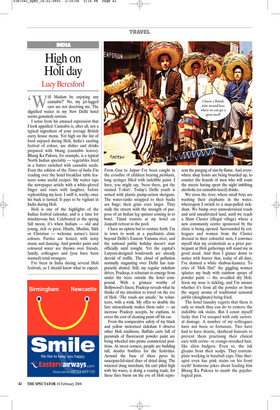High on Holi day
Lucy Beresford
‘Will Madam be enjoying any cannabis?’ No, my jet-lagged ears are not deceiving me. The dignified waiter in my New Delhi hotel seems genuinely curious.
I sense from his amused expression that I look appalled. Cannabis is, after all, not a typical ingredient of your average British curry house menu. Yet high on the list of food enjoyed during Holi, India’s exciting festival of colour, are dishes and drinks prepared with bhang (cannabis leaves). Bhang Ka Pakora, for example, is a typical North Indian speciality — vegetables fried in a batter enriched with cannabis seeds. Even the edition of the Times of India I’m reading over the hotel breakfast table features some useful recipes. My waiter taps the newspaper article with a white-gloved finger and roars with laughter, before replenishing my lassi. I sniff it, warily, once his back is turned. It pays to be vigilant in India during Holi.
Holi is one of the highlights of the Indian festival calendar, and is a time for mischievous fun. Celebrated at the spring full moon, it’s when Indians — old and young, rich or poor, Hindu, Muslim, Sikh or Christian — welcome nature’s latest colours. Parties are hosted, with noisy music and dancing. And powder paint and coloured water are thrown over friends, family, colleagues and (you have been warned) total strangers.
I’ve been in India during several Holi festivals, so I should know what to expect. From Goa to Jaipur I’ve been caught in the crossfire of children bearing pichkaris, long syringes filled with indelible paint. I have, you might say, ‘been there, got the stained T-shirt’. Today’s Delhi youth is armed with plastic pump-action shotguns. The water-tanks strapped to their backs are huge; their grins even larger. They stalk the streets with the strength of purpose of an Indian leg spinner coming in to bowl. Timid tourists at my hotel on Janpath retreat to the pool.
I have no option but to venture forth. I’m in town to work at a psychiatric clinic beyond Delhi’s Eastern Yamuna river, and the national public holiday doesn’t start officially until tonight. Yet the capital’s Lutyens-designed boulevards are already devoid of traffic. The cloud of pollution normally stagnating over Delhi has temporarily abated. Still, my regular rickshaw driver, Pradeep, is reluctant to emerge from under the trees outside the hotel compound. With a grimace worthy of Bollywood’s finest, Pradeep reveals what he thinks of my intention to travel on the eve of Holi. ‘The roads are unsafe,’ he volunteers, with a wink. My offer to double the fare miraculously makes them safer — an increase Pradeep accepts, he explains, to cover the cost of cleaning paint off his car.
From the comparative safety of my black and yellow motorised rickshaw I observe other Holi traditions. Buffalo carts full of pyramids of fluorescent powder paint are being wheeled into prime commercial positions. At street corners, people are building tall, slender bonfires for the festivities. Around the base of these pyres lie saucepan-lid-sized discs of dried dung. The wizened dung merchant, his cart piled high with his wares, is doing a roaring trade, for these fires burnt on the eve of Holi repre sent the purging of sins by flame. And everywhere shop fronts are being boarded up, to counter the hoards of men who will roam the streets having spent the night imbibing alcoholic (or cannabis-laced) drinks.
We cross the river, where small boys are washing their elephants in the water, whereupon I switch to a man-pulled rickshaw. We bump over unmodernised roads and arid uncultivated land, until we reach a Slum Cluster (illegal village) where a new community centre sponsored by the clinic is being opened. Surrounded by colleagues and women from the Cluster dressed in their colourful saris, I convince myself that my credentials as a prior participant at Holi gatherings will stand me in good stead. And then I glance down to notice with horror that, today of all days, I’ve donned a white shalwar-kameez. To cries of ‘Holi Hai!’ the giggling women splatter my body with rainbow sprays of powder paint — the so-called dry Holi. Soon my nose is tickling, and I’m unsure whether it’s from all the powder or from the sugary aroma of traditional seasonal jalebis (doughnuts) being fried.
The hotel laundry regrets that there is only so much they can do to remove the indelible ink stains. But I count myself lucky that I’ve escaped with only sartorial damage. A number of my colleagues have not been so fortunate. Two have had to have drastic, skinhead haircuts to prevent them practising their clinical care with ceriseor orange-streaked hair, like alien badgers. Even so, the ink gleams from their scalps. They contemplate working in baseball caps. One therapist even has pink stains on his front teeth! Someone jokes about feeding him Bhang Ka Pakora to numb the psychological pain.


















































































 Previous page
Previous page